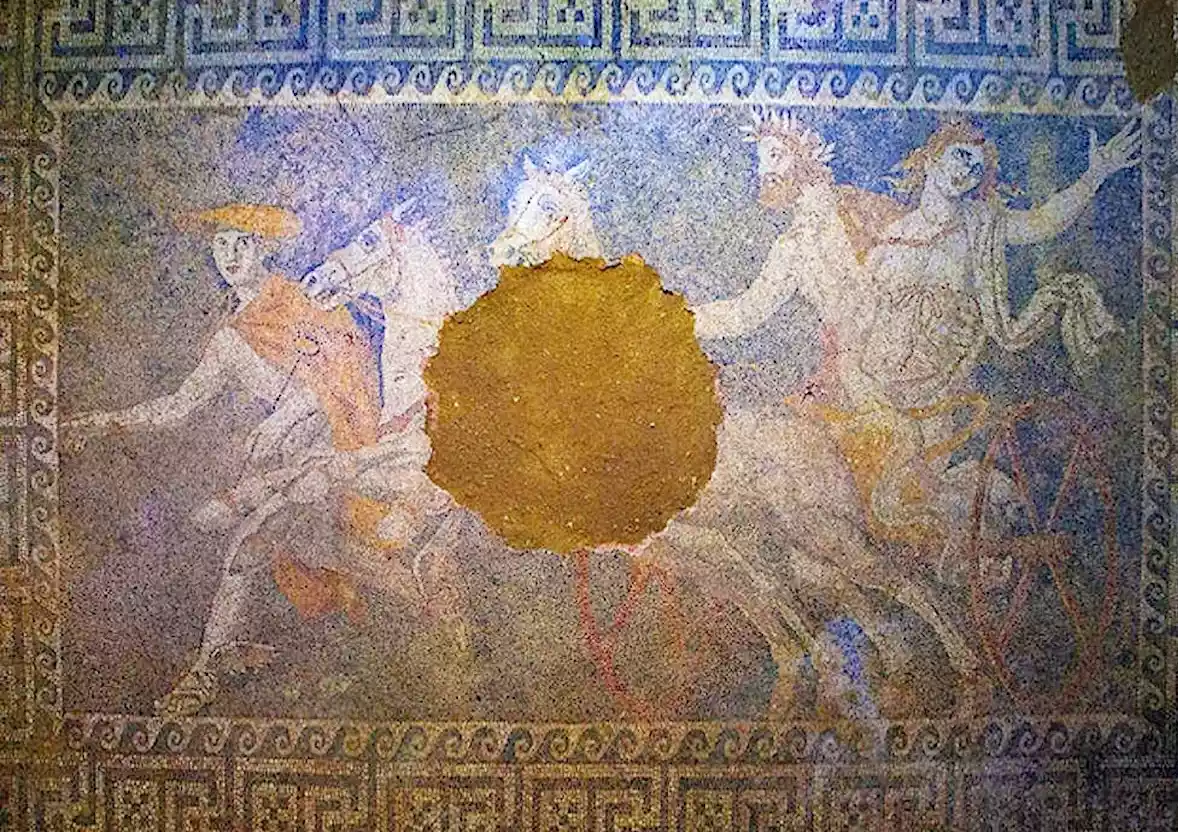
Persephone, the daughter of Demeter and Zeus, remains one of the most enigmatic figures in Greek mythology. Her story, deeply intertwined with the changing seasons and the eternal cycle of life and death, has captivated audiences for centuries, from ancient times to today. This enduring myth serves as a powerful source of inspiration for artists, writers, and poets, resonating with themes of loss, renewal, and the cyclical nature of existence. Within the Olympian pantheon, Persephone held a unique position, embodying both the vibrant energy of spring and the somber reign of the underworld. As the wife of Hades, she ruled the realm of the dead for part of the year, while spending the remaining time in the world above with her mother, Demeter. This cyclical journey between light and darkness, life and death, mirrors the perpetual renewal of nature and the turning of the seasons. Persephone’s story is more than a mere legend; it’s a profound symbol of life’s deepest mysteries, encapsulating themes of transformation, rebirth, and the interconnectedness of all things.
The Abduction of Persephone: A Catalyst for Change
The myth of Persephone begins with her dramatic abduction by Hades, the god of the underworld. While gathering flowers, the unsuspecting Persephone, enchanted by their beauty, wandered away from her companions and fell victim to the dark god’s desire. Hades, captivated by Persephone’s radiant beauty, forcefully took her to be his queen in the subterranean realm. This act of violence set in motion a chain of events that would forever alter the balance between the mortal and immortal worlds, leading to profound consequences for both gods and humans.
Hades and the Underworld: A Realm Transformed
Hades, as the ruler of the underworld, was a god who inspired fear and awe in mortals. His kingdom, a gloomy and mysterious place, served as the final destination for souls after death. However, Persephone’s presence brought a new vibrancy to this somber domain. Her beauty and grace illuminated the dark paths of Hades, and the love that blossomed between them infused the god of death with a new sense of purpose. Their relationship, born from abduction, evolved into a complex bond, representing not just dominion but also a unique form of companionship in the realm of shadows.
Demeter’s Grief: A World in Winter
Persephone’s disappearance caused immeasurable sorrow for her mother, Demeter, the goddess of agriculture and fertility. Demeter, consumed by grief, wandered the earth in a desperate search for her daughter. In her despair, she refused to allow the earth to bear fruit, plunging the world into an endless winter. The absence of Persephone had devastating consequences, not only for Demeter but also for all of humanity, who faced the threat of famine and extinction. As Cheryl Downing explores in her book “The Long Journey Home: Revisioning the Myth of Demeter and Persephone for Our Time,” this maternal grief highlights the profound connection between mother and child and explores the themes of loss and resilience. The imagery of a world plunged into perpetual winter further resonates with contemporary audiences, echoing concerns about environmental disruption and the delicate balance of nature.
The Compromise of Zeus: Restoring Balance
Faced with the prospect of eternal famine and chaos, Zeus, the father of the gods, was compelled to intervene. He brokered a compromise between Hades and Demeter, stipulating that Persephone would spend a portion of the year in the underworld as Hades’ wife, and the remaining time in the world above with her mother. This agreement restored balance to the world, as Persephone’s return to Demeter marked the arrival of spring and the renewal of nature, while her descent to Hades ushered in autumn and winter, thus establishing the cyclical rhythm of the seasons. This myth, through the lens of contemporary understanding, can be interpreted as a reflection of the natural world’s inherent duality: the interplay between light and darkness, growth and decay, joy and sorrow. The story serves as a reminder that life is a series of transitions, a constant movement between opposing forces, and it is in this dynamic interplay that true harmony and balance can be found. The abduction of Persephone initiates an epic journey of transformation, not only for the goddess herself but also for the world around her. Through sorrow, compromise, and eventual reconciliation, the myth reveals the profound connections between life and death, joy and pain, loss and renewal, demonstrating the cyclical nature of existence and the enduring power of love.
Persephone: Symbol of Transformation and Eternal Renewal
Persephone’s narrative transcends the simple tale of a goddess abducted by Hades; it embodies profound themes of metamorphosis, change, and personal evolution. Her journey to the underworld and subsequent return to the world above signifies a radical transformation, one that resonates with our own life experiences and personal growth. This cyclical journey mirrors the universal human experience of navigating through periods of darkness and light, loss and gain, and the constant flux between stability and change. Just as Persephone’s myth underscores the cyclical nature of existence, so too does it highlight the importance of embracing change as an integral part of life’s journey.
The Cycle of Seasons: A Mirror of Human Experience
Persephone’s myth is inextricably linked to the changing seasons. Her time spent in the underworld and her return to the land of the living symbolize the eternal flow of time and the cyclical rhythm of nature. Much like Persephone, we too experience periods of darkness and light, grief and joy, stagnation and growth. The myth reminds us of the ephemeral nature of all things and reinforces the concept that after every winter, spring will inevitably follow, bringing with it renewed hope and the promise of rebirth. This cyclical pattern is mirrored in our own lives, where we experience highs and lows, periods of growth and dormancy, echoing the natural world’s constant state of flux.
Rebirth and Renewal: Embracing the Potential for Transformation
As the goddess of spring and rebirth, Persephone embodies the concept of renewal and fresh beginnings. Her return from the underworld marks the awakening of nature and the resurgence of life after a period of dormancy. This concept of rebirth is applicable to our own lives as well. We often go through times of stagnation or hardship, but we always have the potential to rise again, learn from our experiences, and emerge stronger and more resilient. Like the natural world that awakens after a long winter, we too possess the capacity for renewal and growth, even after facing periods of adversity.
Death and Life: Intertwined and Inseparable
One of the most profound messages of Persephone’s myth is the interconnected nature of life and death. As queen of the underworld, Persephone becomes the bridge between the living and the dead, reminding us that death is an integral part of existence. Yet, her periodic return to the world above also teaches us that life always triumphs, and that even in the darkest of times, there is always hope for renewal and regeneration. This duality emphasizes the interconnectedness of seemingly opposing forces, highlighting how life and death are not mutually exclusive but rather two sides of the same coin.
Persephone, as a symbol of transformation, invites us to embrace change and to recognize the strength that lies within life’s trials and transitions. Her journey becomes a blueprint for our own path toward personal growth and self-discovery, reminding us that even the darkest periods can lead to a deeper understanding of ourselves and the world around us.
The Enduring Legacy of Persephone’s Myth
The myth of Persephone is not merely a story from the distant past. It is a narrative that continues to resonate across centuries, touching the hearts and minds of people in every era. The legacy of this myth extends beyond the boundaries of ancient Greek mythology, permeating culture, art, thought, and human experience.
In Art and Literature: An Eternal Source of Inspiration
Persephone’s story has been a source of inspiration for countless artists and writers throughout the ages. From ancient tragedies to contemporary literature, creators have explored the deeper meanings and symbolic elements of the myth, adapting it to their own context and era. The myth of Persephone has shaped artistic imagination, providing a lens through which creators explore themes such as loss, coming-of-age, transformation, and the resilience of the human spirit.
In Psychology and Philosophy: A Journey Towards Self-Discovery
Beyond its artistic influence, the myth of Persephone has gained particular significance in the fields of psychology and philosophy. The story of the goddess who travels between the upper and lower worlds has been interpreted as an allegory for the individual’s inner journey toward self-knowledge and wholeness. Carl Jung, a pioneer of analytical psychology, saw in the myth of Persephone an archetype for the process of individuation, during which the individual confronts and integrates the dark aspects of their self (Daifotis, 2017).
In the Modern Era: Finding Resonance in Contemporary Challenges
In the modern era, the myth of Persephone continues to resonate in ways that are both personal and universal. In a world marked by rapid change, uncertainty, and challenges, the story of the goddess who overcomes adversity and emerges transformed can offer comfort, inspiration, and hope. The myth of Persephone reminds us that life is full of cycles and transitions, and that even the darkest periods can lead to growth, maturity, and self-awareness. The themes of resilience, transformation, and the cyclical nature of life offer a sense of continuity and hope in the face of constant change.
Ultimately, the legacy of Persephone’s myth lies in its timeless ability to touch the deepest chords of human experience. It is a story that speaks to the power of transformation, the resilience of the spirit, and the eternal capacity of humanity to find meaning and beauty even in the most difficult circumstances. As we continue to recount and interpret this myth, Persephone remains a potent symbol of hope, renewal, and the indomitable strength of the human spirit.
Conclusion: Embracing Change and Finding Strength in Transformation
The myth of Persephone stands as a timeless symbol of transformation, resilience, and rebirth. Through the goddess’s adventurous journey, from her abduction by Hades to her eventual reconciliation with her fate, the deepest truths of human existence are reflected. The myth teaches us that life is full of cycles and transitions, and that even the darkest periods can lead to personal growth and self-discovery. As we continue to recount and interpret this story, Persephone’s legacy remains alive, inspiring and guiding us on our own journey of transformation. This enduring myth serves as a reminder that change is not something to be feared, but rather an opportunity for growth, renewal, and a deeper understanding of ourselves and the world around us.
elpedia.gr
Βιβλιογραφία
- Daifotis, M. (2017). The Myth of Persephone: Body Objectification from Ancient to Modern. Claremont McKenna College. claremont.edu
- Downing, C. (2001). The long journey home: Revisioning the myth of Demeter and Persephone for our time. Shambhala. books.google.com
- Stange, G. R. (1954). Tennyson’s Mythology: A Study of Demeter and Persephone. ELH, 21(4), 283–294. jstor.org

